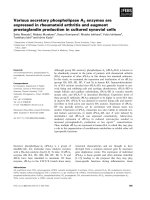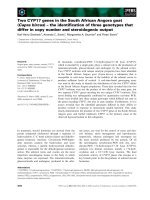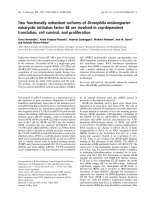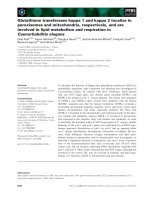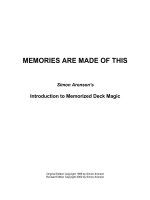Draw and paint 50 animals
Bạn đang xem bản rút gọn của tài liệu. Xem và tải ngay bản đầy đủ của tài liệu tại đây (21.45 MB, 343 trang )
draw AND paint 50 animals
Jeanne Filler Scott
Contents
1 Getting Started
Drawing Materials
Painting Materials
Acrylics
Oils
Beginning a Painting
Types of Pencil Strokes
Types of Brushstrokes
Creating Backgrounds
Finding Animal Subjects
Gathering References
2 Cats
Project 1:Domestic Shorthair
Project 2: Kitten
Project 3: Domestic Longhair
Project 4: Siamese
3 Dogs
Project 5: Dalmatian
Project 6: Mixed Breed
Project 7: Yorkshire Terrier
Project 8: Golden Retriever
4 Horses
Project 9: Thoroughbred
Project 10: Shetland Pony
Project 11: Foal
Project 12: Paint Horse
Project 13: Draft Horse
Project 14: Appaloosa
Project 15: Thoroughbred Foal
Project 16: Lipizzaner Stallion
Project 17: Arabian Filly
Project 18: Friesian Stallion
Project 19: Arabian Gelding
5 Cattle
Project 20: Calf
Project 21: Cow’s Head
Project 22: Holstein
6 Barnyard Animals
Project 23: Chicks
Project 24: Ducks
Project 25: Pig
Project 26: Rooster
7 Rabbits
Project 27: Dutch Rabbit
Project 28: Cottontail Rabbit (Front View)
Project 29: Cottontail Rabbit (Side View)
8 Squirrels
Project 30: Gray Squirrel
Project 31: Red Squirrel
Project 32: Columbian Ground Squirrel
9 Foxes
Project 33: Red Fox
Project 34: Gray Fox
Project 35: Fox Cub
10 Raccoons & Woodchucks
Project 36: Raccoon
Project 37: Woodchuck
Project 38: Raccoon Baby
11 Ferrets & Otters
Project 39: Ferret
Project 40: Otter
12 Woodland Animals
Project 41: White-Tailed Deer
Project 42: Chipmunk
Project 43: Black Bear
13: Exotic Animals
Project 44: Elephant
Project 45: Giraffe
Project 46: Zebra Foal
Project 47: Ring-Tailed Lemur Baby
14 Birds
Project 48: Peacock
Project 49: Parrot
Project 50: Hyacinth Macaws
1 Getting Started
To get started drawing and painting, you will need the right supplies. You don’t
have to buy the most expensive art supplies, but you should get the best available
to you. Remember, the most expensive brushes aren’t the key to becoming a
master, and a good artist can use moderately priced brushes to produce a
masterpiece!
Three mediums are used in this book: acrylics, oils and pencil. In this section, I’ll
provide you with a list and description of everything you’ll need for each medium. I’ll
also cover some basic techniques to get you started drawing and painting as well as
finding references.
We’ll start with pencil drawings, which require just a few simple materials:
SURFACE
Bristol paper with a smooth finish makes an excellent surface for fine pencil work
and withstands some erasure without roughening the paper surface. You can also
use hot-pressed illustration board, which has slightly more texture than the bristol
paper and can also withstand erasures.
PENCILS
Use a no. 2 pencil for your preliminary underlying sketch, whether you’re sketching
directly on the bristol paper or transferring your sketch with tracing paper.
For the final drawing, use ebony pencils. They are jet black and smooth to work
with because they are softer and denser than ordinary pencils. This also makes
them easier to blend with a stump.
KNEADED ERASER
The kneaded eraser is best for pencil work as it erases cleanly and can be formed
into any shape for detailed erasures. Also, you can easily clean the eraser by
kneading and working it around. You can use a kneaded eraser to lighten areas that
have gotten too dark by repeatedly pressing the eraser lightly onto the area until it
is the right tone.
BLENDING STUMP
Similar to tortillions, stumps are made of soft, tightly spiral-wound paper. They are
a good tool for smoothing and blending and give a softer look to some areas of your
drawing than can be achieved by the pencil alone.
PENCIL SHARPENER
It’s important to have a good pencil sharpener, preferably electric, so you can
quickly sharpen your pencils to a fine point. It’s a good idea to sharpen several
pencils at once so when one gets dull, you don’t have to stop to sharpen it.
SPRAY FIXATIVE
Spray fixative stabilizes drawings so that the penciling won’t smudge or smear if it is
accidentally touched or rubbed. Workable fixative is best since it provides lasting
protection, yet you can still rework the drawing if you decide to make changes.
Apply it in a place with plenty of ventilation, placing the drawing on a larger piece of
scrap paper or cardboard so you don’t get the spray onto anything else. Cover the
surface uniformly but without drips.
Gather Your Supplies
Here is what you’ll need for your pencil drawings: a surface (bristol paper or illustration board), a no. 2 pencil, ebony
pencils, kneaded eraser, blending stumps and spray fixative. It’s also useful to have a good pencil sharpener and
tracing paper for transferring your sketch to the surface. Drawing supplies are relatively inexpensive and easy to
order over the Internet.
Painting Materials
The list of materials you’ll need for painting is more extensive than for drawing.
However, basic painting supplies are well worth the expenditure since they’ll
provide you hours of satisfaction and enjoyment as you create your own paintings.
SURFACE
The surface for most of the oil and acrylic painting demonstrations in this book is
Gessobord, a pre-primed Masonite panel with a nice texture for realistic painting. It
comes in a variety of sizes. I completed most of the demonstrations on 8″ × 10″
(20cm × 25cm) panels. Illustration board is fine for acrylic paintings, but since it is
paper based, it is not suitable for oils. Although I prefer Gessobord for finished oil
and acrylic paintings because of its permanence and smoother surface, illustration
board has the advantage of being less expensive to buy, and it can be easily cut to
any size you desire.
PAPER TOWELS
Paper towels are useful for blotting excess paint, water, turpentine or medium from
your brush. Keep a folded paper towel by your palette and a crumpled one in your
hand or on the table.
MEDIUM
Medium improves the flow of the paint so it is easier to spread and blend, and it can
also be used for glazing. For acrylics, I use plain water instead of a manufactured
medium. For oil painting, I use Winsor & Newton Liquin. It improves the flow of
paint, makes the paint dry faster and is good for blending and glazing. I use
turpentine or a turpentine substitute to thin a neutral color for blocking in the form
in the first step of the painting and for cleaning brushes.
When painting with acrylics, it’s important to change the water fairly frequently so
it doesn’t get too murky with paint. For oils, you may have to change your
turpentine occasionally if it gets too saturated with paint. Always wipe as much
paint from your brushes as possible with a paper towel before cleaning them.
NO. 2 PENCIL AND KNEADED ERASER
You’ll need a pencil and an eraser for drawing or tracing the image onto your panel.
The kneaded eraser is good for making corrections and for lightening pencil lines so
that they won’t show through the paint.
TRACING PAPER
You’ll need tracing paper if you want to trace your sketch or the template drawing
provided with each demonstration. After tracing your sketch, you can transfer it to
the Gessobord using homemade carbon paper. The advantage of doing the sketch
on a separate piece of paper, and not directly onto the panel, is that you have much
more control over the size and placement of the subject, often resulting in a better
painting.
VARNISH
When an oil painting is completely dry (which can take six months to a year,
depending on how thick the paint is), it should be varnished with a final picture
varnish for total surface protection and to restore colors. You should keep a
schedule and inform people who receive your art that they or someone else must
apply the varnish to preserve the value of their acquisition. Although it isn’t
necessary, some artists also choose to varnish acrylic paintings because they want
the painting to appear glossier or to add a protective layer.
Versatile Materials
Many of the same materials used for oil painting can also be used for acrylics —brushes, surface (Gessobord),
palette knife, paper towels, no. 2 pencils and tracing paper. The difference is in the paints (oil or acrylic), medium
(Liquin or water) and type of palette (disposable wax paper or Masterson Sta-Wet Palette).
PALETTE
The Masterson Sta-Wet Palette works well for acrylics because it keeps your paints
from drying out for days or even weeks. The 12″ × 16″ (30cm × 41cm) size is best
as it gives you plenty of room to mix colors. The palette consists of a 1
3
⁄
4
-inch
(4cm) deep plastic box with a sponge insert that fills the bottom of the box when
wet. A special disposable paper, called acrylic film, sits on top of the sponge insert.
The box has an airtight lid.
For oil painting, I use a 12″× 16″ (30cm × 41cm) disposable wax paper palette.
When you are finished with a sheet, you just tear it off and discard and use the new
sheet underneath. A plastic box with a lid (similar to the one for the Masterson Sta-
Wet Palette) will help keep your paints from drying out.
PALETTE KNIFE
You’ll need a palette knife for mixing both oil and acrylic colors. A tapered steel
knife works best, and the trowel type with a handle lifted above the blade is the
easiest to use. Be sure to clean your palette knife between colors. Wiping it on a
paper towel is usually sufficient, but occasionally you’ll have to rinse it in water or
turpentine.
WAX PAPER
It’s useful to keep wax paper on hand for times when you want to paint a thicker
acrylic layer (the Sta-Wet Palette always adds some water to the paint). Simply
transfer some color from your palette to the wax paper. The wax paper will prevent
the paint from becoming diluted, and the paint will immediately begin to dry out
and thicken. Lightly spray the paint with water to keep it from drying up completely.
Acrylic Palette Tip
The directions that come with the Masterson Sta-Wet Palette tell you not to
wring out the wet sponge. However, I find that if I don’t gently press out some
of the water, my paints become too runny after a short time. If the paints start
to dry out, spray them lightly with water from a spray bottle.
Palette Types
Oils and acrylics require different types of palettes, but you can use the same palette knife for both mediums.
Keep Multiples of Each Brush Size
It’s a good idea to have two or three copies of each of the round sizes and at least two of each of the filberts.
That way, you can use two or three brushes alternately with different colors to blend without having to stop and
clean your brush each time.
BRUSHES
I keep on hand dozens of brushes in all different brands, types and sizes. The
numbers used to designate the sizes of brushes vary widely from one manufacturer
to another. For example, a no. 1 round of one brand could be a very small brush
used for detail, while a no. 1 round of a different brand could be much larger and
not at all suitable for small detail. I’ve found that even within one brand, the length
of the handle (long or short) can make a big difference in the size number. When I
paint, I tend to pick up any brand of brush in a size and type that looks right for
what I am doing. This method seems the most practical.
The brushes I use are made of a synthetic sable called golden Taklon and have
firmness as well as flexibility. In order to have the right mix of types and sizes, I
have used both long- and short-handled brushes.
There are several brush sizes used for the demonstrations in this book, including:
Rounds: no. 1, 4 and 6 with short handles.
Filberts: no. 6 and 10 with short handles and no. 2 and 4 with long handles.
Brights: no.10 (a stiff, short-haired flat brush).
Shaders: no. 8 and 10, good for backgrounds.
Rounds come to a fine point and are best for detail, such as animal eyes or blades
of grass. Filberts are good for broader areas like large areas of grass or sky. They
hold a lot of paint and are tapered so that it’s easier to paint around objects.
It’s best to have two or three of the more frequently used brushes, such as no. 1,
3, 4 and 10 rounds and no. 2 and 6 filberts. As you’ll see in the demonstrations, you
will often need two or three of the same size brush, each with a different color, so
you can use them alternately while blending.
You can use the same brushes for the oil and acrylic demonstrations in this book.
Just be sure to wash the brushes well at the end of your painting sessions. For
acrylics, you need only to rinse the brushes well in water. For oils, you must rinse
the brushes out well in turpentine or turpentine substitute, blot on a paper towel,
then use water and a brush cleaner such as the Masters Brush Cleaner and
Preserver to complete the cleaning. You can also use dish soap for this purpose.
Acrylics
I painted the demonstrations in this book with Liquitex Heavy Body Professional
Artist Acrylic Colors that come in tubes. I like these paints because they have a
good consistency —smooth but not runny —and can either be thinned to a
watercolor-type glaze or applied in a thicker, more opaque layer with lots of
possibilities in between. They are also permanent and richly colored, and will not
crack or yellow when dry. However, there are many brands of acrylic paint
available, so experiment and find out what works best for you. The colors I use
most in this book include: Burnt Sienna, Burnt Umber, Cadmium Orange, Cadmium
Red Medium, Cadmium Yellow Deep, Cerulean Blue, Hansa Yellow Light, Hooker’s
Green Permanent, Naples Yellow, Raw Sienna, Red Oxide, Scarlet Red, Titanium
White, Ultramarine Blue and Yellow Oxide.
MIXING ACRYLIC COLORS
Painting with pigments straight from the tube results in garish, unrealistic colors.
Most of the colors you use will be a mixture of two or more pigments.
Be sure to mix a large enough quantity of each color so that you have enough to
finish the painting. This is easier than trying to mix the same color a second time.
Save all of your color mixtures until you have completed the painting. You never
know when you may need a color again to reestablish a detail, for example. You
can also use a previously mixed color as the basis for a new color by simply adding
another color or two to a portion of a mixture you’ve already created.
Acrylic Color Requirements
Here are a few of the acrylic paints I use in this book. The colors required in the demonstrations vary with the
subject, some requiring more or different colors than others.
USEFUL ACRYLIC MIXTURES
Here are some useful color mixtures:
Warm black: Mix Burnt Umber and Ultramarine Blue to paint an animal’s coat. This black looks more natural than
black from a tube.
Warm white: For painting highlights in animal fur, clouds or wildflowers, mix Titanium White and a touch of Hansa
Yellow Light or Yellow Oxide.
Basic green: Mix a basic green for grass and trees with Hooker’s Green Permanent, adding a little Cadmium
Orange and Burnt Umber to tone down the green. For darker shadows, mix in some Ultramarine Blue and more
Burnt Umber. For highlight colors, add some Titanium White and Naples Yellow or Hansa Yellow Light.
Basic grass: Mix a basic grass color with Hooker’s Green Permanent, Titanium White, Naples Yellow and a little
Cadmium Orange.
Bluish green: For distant trees, mix Titanium White, Hooker’s Green Permanent, Ultramarine Blue and a bit of
both Cadmium Orange and Raw Sienna.
Natural pink: For noses and white-furred animals, mix Titanium White, Scarlet Red and Burnt Umber or Burnt
Sienna.
Bluish shadow color: For shadowed areas in light, mix Titanium White, Ultramarine Blue and a little Burnt Umber
or Burnt Sienna.
Blue sky: Create this color with Titanium White, Ultramarine Blue and a touch of Naples Yellow. For a brighter
blue, use Cerulean Blue instead of Ultramarine Blue.
Oils
I completed the oil demonstrations in this book with Grumbacher Pre-tested Oil
colors, with the addition of Permalba White, a product of the Martin/F. Weber Co.
Permalba White, a mixture of Titanium White and Zinc White, has a creamy,
spreadable texture that makes it easy to paint with and to mix with other colors.
The oil colors I used in this book include: Burnt Sienna, Burnt Umber, Cadmium
Orange, Cadmium Red Light, Cadmium Yellow Light, Cerulean Blue, Naples Yellow,
Permalba White, Raw Sienna, Ultramarine Blue Deep, Viridian and Yellow Ochre.
OIL COLOR MIXTURES
Oil color mixtures are basically the same as the acrylic mixtures, except some of the
colors are a little different and have different names (never mix oil and acrylic
paints). Substitutions for acrylic to oil are as follows:
• For Ultramarine Blue, use Ultramarine Blue Deep. (Ultramarine Blue is available
in some oil brands, but Grumbacher makes Ultramarine Blue Deep.)
• For Scarlet Red, use Cadmium Red Light.
• For Titanium White, use Permalba White. (Titanium White is also an oil color,
but I prefer Permalba White.)
• For Hooker’s Green Permanent, use Viridian.
• For Yellow Oxide, use Yellow Ochre.
• For Hansa Yellow Light, use Cadmium Yellow Light.
• For Red Oxide, use Indian Red.
RETOUCH VARNISH
Oil paints tend to dry to a duller finish than when wet, which can make matching
color mixtures difficult in subsequent painting sessions. Try applying damar retouch
varnish once the painting is dry to the touch. Be sure to use with plenty of
ventilation. The varnish takes only a few minutes to dry. Retouch varnish
temporarily restores the luster and color to a painting so that it looks the same as
when you first applied the wet paint. Since it is thin, retouch varnish allows the
paint to keep drying underneath, which will prevent it from cracking later. When the
painting is finished and fully dry, apply the final picture varnish. The colors will be
restored and will all match because you used retouch varnish when starting each
new painting session.
Oil Paint Brand Choices
I like Grumbacher oil colors because they are archival and permanent with rich color and a smooth consistency.
There are many brands of oil paints available, so experiment and find out what works best for you.
Test Your Mixtures
When mixing a color on your palette, you can’t be certain how it will look in the
painting until you see it next to the other colors. Test the mixture by placing a
small dab on the area to be painted. You can then modify the color so it will be
the best for your painting.
Beginning a Painting
Template line drawings of each animal are provided with most of the
demonstrations in this book. You can use these templates or create your own
sketches.
TRANSFERRING YOUR SKETCH
Whether you use the template or a sketch of your own, use a piece of tracing paper
and a fine-point black marker to trace the image.
You can enlarge or reduce the size of the image to fit your panel with a copy
machine or an opaque projector. If you use a photocopy, blacken the back of the
copy with a no. 2 pencil, then tape the copy to your panel and trace the image with
a pencil. You’ll need to bear down with a fair amount of pressure, but this should
result in transferring the graphite from the back of your photocopy onto the panel.
Lift the tracing or copy paper occasionally to make sure you are pressing down hard
enough and are getting the complete image. If your tracing comes out too dark (so
that it will show through the paint), use a kneaded eraser to lighten it.
If you use an opaque projector, you can trace the sketch directly onto the panel
from the projected image. This is a little more difficult than you might think, since
you have to stand to one side so you don’t block the light from the projector.
DOING AN UNDERPAINTING
Once you have a pencil sketch on your panel, you are ready to do the
underpainting. Neutral colors such as Burnt Umber or Payne’s Gray, thinned with
water, are good for this. As a rule of thumb, use Burnt Umber for brown or warm-
colored animals—such as a chestnut horse—and Payne’s Gray for gray, black or
white animals—such as a dalmatian.
Squeeze out some of the underpainting color onto your palette, then mix it with a
small amount of the water on the palette’s surface. You want the paint to be thin
but not too runny. Begin to paint, not worrying much about detail at this point. Just
establish the main lines and the lights and darks. The purpose of the underpainting
is to give you a rough guide to go by when you begin painting in full color.
GENERAL STEPS FOR COMPLETING THE PAINTING
Once you have finished the underpainting, you are ready to apply the darkest value
colors. This is followed by the middle value and then the lightest value colors. You
will start with a small amount of detail, building upon this and adding more detail
with each step. Doing a realistic painting is basically a process of refining as you go
along and building upon what you’ve already done. In the final step, you will paint
the finishing details.
THICKNESS OF THE PAINT
When painting with acrylics, use just enough water so that the paint flows easily.
You will usually need to apply two to three layers to cover an area adequately.
Since the paint dries so quickly, this is easily accomplished. In general, shadows are
painted fairly thin, while highlighted areas benefit from a little more thickness,
which makes them stand out.
Transferring Your Sketch
With homemade carbon paper positioned underneath, the sketch is easily traced onto the panel.
Make Your Own Carbon Paper
Make your own carbon paper by blackening the back of a blank piece of tracing
paper with a no. 2 pencil. You can use this homemade carbon paper over and
over.
Types of Pencil Strokes
Here are some useful pencil strokes to use when sketching your preliminary animal
drawings.
Smooth Parallel Strokes
With constant pressure on the pencil, lightly draw parallel lines of roughly the same length. This is a good basic
shading technique.
Crosshatching
Shade with parallel lines, then shade over the first set of lines with strokes that go in a different direction.
Crosshatching darkens areas more smoothly than simply shading in one direction.
Blending With a Stump/Tortillion
Rub a stump over pencil shading to soften and blend. Create different effects by varying the direction and pressure
on the stump.
Layering Lines and Blending
Adding more pencil shading over a blended area can yield nice effects. Use the stump again, alternating between
pencil and stump to achieve the desired texture.
Long, Curving Strokes
Use these strokes for tall grass, weeds and strands of hay or straw.
Flowing Strokes
These pencil strokes are good for flowing manes and tails.
Straight, Slightly Curved Strokes
Use these strokes for the stiff, slightly bending hairs of a donkey or zebra mane. These strokes are also good for
depicting mowed grass.
Types of Brushstrokes
Learning to handle your brush is crucial in depicting the texture of fur, clouds, grass
and feathers. There are several types of strokes you should be familiar with when
painting the natural world.
Dabbing Vertical Strokes
These strokes are done quickly, in a vertical motion, with either a round or a flat brush. They are good for painting
the texture of grass in a field.
Smooth Flowing Strokes
These strokes are good for long hair, such as a horse’s mane or a long-haired cat’s tail. Use a round brush with
enough water so the paint flows, and make the strokes flowing and slightly wavy.
Dabbing Semicircular Strokes
These are done fairly quickly, in a semicircular movement, with a flat brush such as a shader. These strokes are
good for skies, portrait backgrounds or other large areas that need to look fairly smooth, such as a wall or floor.
Small Parallel Strokes
Use this kind of stroke to paint detail, such as short animal fur or bird feathers, using the tip of your round. Be sure
to paint in the direction the hair or feathers grow on the animal.
Glazing
A glaze or wash is used to modify an existing color by painting over it with a different color thinned with water so
that the original color shows through. This creates a new color that you couldn’t have achieved any other way. Dip
your brush in water, then swish it around in a small amount of the glazing color. Blot briefly on a paper towel so you
have a controllable amount of the glaze on your brush, then paint the color smoothly over the original color. In this
detail of a log, a glaze of Burnt Sienna was painted over a portion of the log to show how the glaze warms up the
colors.
Drybrush or Scumbling
This is when you modify a color you’ve already painted by painting over it with another color in an opaque fashion,
so that the first color shows through. Dip a moist, not wet, brush into the paint, then rub it lightly on a paper towel
so that there is just enough paint to create a broken, uneven effect when you paint over the original color. Repeat
as necessary.
Smooth Horizontal or Vertical Strokes
These strokes are good for man-made objects and water reflections. Using enough water so the paint flows but is
not runny, move your round brush evenly across the surface of the panel.



